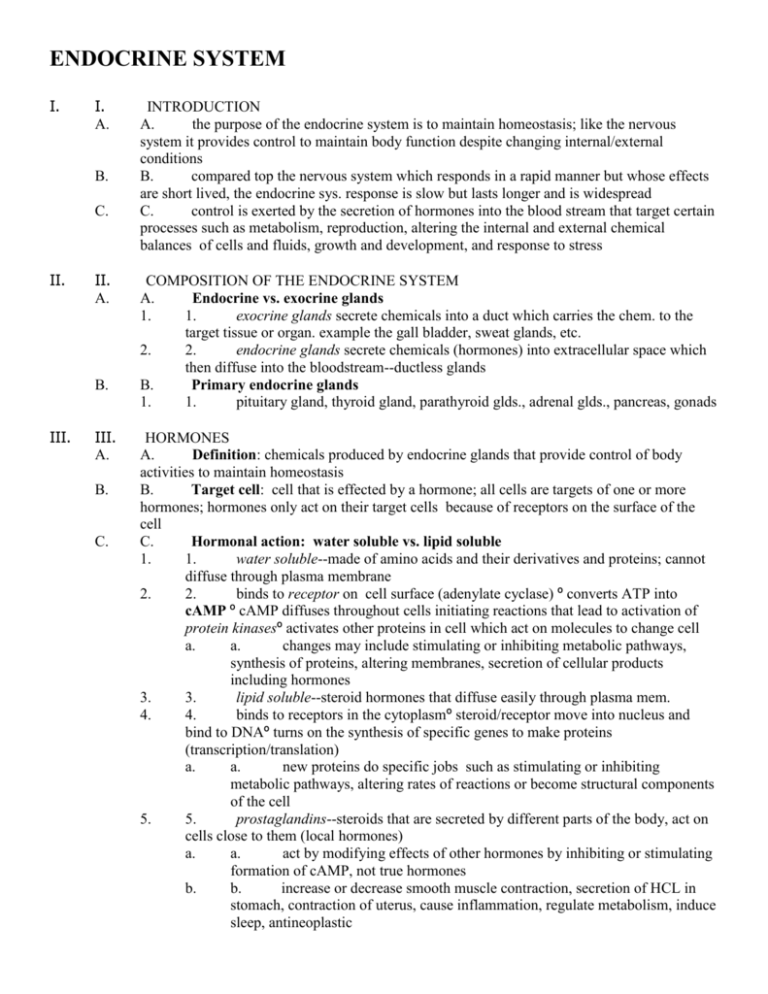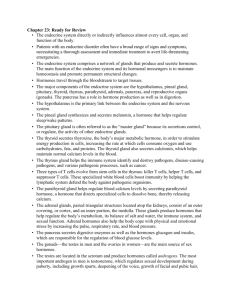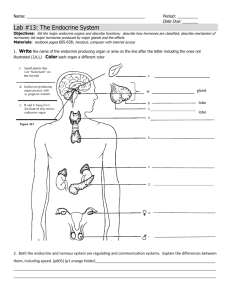ENDOCRINE SYSTEM
advertisement

ENDOCRINE SYSTEM I. I. A. B. C. II. II. A. B. III. III. A. B. C. INTRODUCTION A. the purpose of the endocrine system is to maintain homeostasis; like the nervous system it provides control to maintain body function despite changing internal/external conditions B. compared top the nervous system which responds in a rapid manner but whose effects are short lived, the endocrine sys. response is slow but lasts longer and is widespread C. control is exerted by the secretion of hormones into the blood stream that target certain processes such as metabolism, reproduction, altering the internal and external chemical balances of cells and fluids, growth and development, and response to stress COMPOSITION OF THE ENDOCRINE SYSTEM A. Endocrine vs. exocrine glands 1. 1. exocrine glands secrete chemicals into a duct which carries the chem. to the target tissue or organ. example the gall bladder, sweat glands, etc. 2. 2. endocrine glands secrete chemicals (hormones) into extracellular space which then diffuse into the bloodstream--ductless glands B. Primary endocrine glands 1. 1. pituitary gland, thyroid gland, parathyroid glds., adrenal glds., pancreas, gonads HORMONES A. Definition: chemicals produced by endocrine glands that provide control of body activities to maintain homeostasis B. Target cell: cell that is effected by a hormone; all cells are targets of one or more hormones; hormones only act on their target cells because of receptors on the surface of the cell C. Hormonal action: water soluble vs. lipid soluble 1. 1. water soluble--made of amino acids and their derivatives and proteins; cannot diffuse through plasma membrane 2. 2. binds to receptor on cell surface (adenylate cyclase) º converts ATP into cAMP º cAMP diffuses throughout cells initiating reactions that lead to activation of protein kinasesº activates other proteins in cell which act on molecules to change cell a. a. changes may include stimulating or inhibiting metabolic pathways, synthesis of proteins, altering membranes, secretion of cellular products including hormones 3. 3. lipid soluble--steroid hormones that diffuse easily through plasma mem. 4. 4. binds to receptors in the cytoplasmº steroid/receptor move into nucleus and bind to DNAº turns on the synthesis of specific genes to make proteins (transcription/translation) a. a. new proteins do specific jobs such as stimulating or inhibiting metabolic pathways, altering rates of reactions or become structural components of the cell 5. 5. prostaglandins--steroids that are secreted by different parts of the body, act on cells close to them (local hormones) a. a. act by modifying effects of other hormones by inhibiting or stimulating formation of cAMP, not true hormones b. b. increase or decrease smooth muscle contraction, secretion of HCL in stomach, contraction of uterus, cause inflammation, regulate metabolism, induce sleep, antineoplastic D. IV. IV. A. D. 1. Hormonal control 1. feedback control--hormones are very potent chemicals, uncontrolled release would not be good ; 2. 2. negative feedback system--provides response on opposite direction of stimulus, the feedback is given by the hormone or its products which inhibit further hormone secretion; most feedback systems in the body are this type a. a. example: parathyroid gland and blood calcium levels 3. 3. positive feedback--provides response in same direction as stimulus, chemical feedback causes endocrine gland to secrete more hormone; move body further from homeostasis a. a. example: oxytocin produced by post. pituitary and uterine contractions 4. 4. nervous control--only controls a few glands which secrete their hormones when they receive nerve impulses THE ENDOCRINE GLANDS A. Pituitary gland 1. 1. located at base of brain, the size of pea weighing .5g, attached to hypothalamus by infundibulum and lies within bony cavity called sella turcica 2. 2. anterior lobe--composed of glandular epithelium enclosed by connective tissue, release of 7 hormones controlled by releasing factors (R) from the hypothalamus a. a. Growth hormone (GH) --stimulates body cells to grow and divide, increases bone deposition, causes cells to increase uptake of A.A.s and increase catabolism, helps maintain blood sugar by increasing conversion of glycogen to glucose b. b. Melanocyte-stimulating hormone (MSH)--increases melanin production in skin c. c. Prolactin (PRL) --stimulates and maintains milk secretion by mammary glands, secretion plus ejection of milk is called lactation, levels of PRL are also influenced by other hormonal changes.. d. d. Thyroid-stimulating hormone (TSH)--stimulates thyroid gland which influences metabolism e. e. Adrenocorticotropic hormone (ACTH)--stimulated to release by RF in hypothalamus and by stress, causes cortex of adrenal gland to produce and release hormones f. f. Follicle stimulating hormone (FSH) -- in females stimulates development of eggs each month and simulates ovaries to produce estrogen; in males FSH stimulates production of sperm, FSH production controlled by hypoth. in response to estrogen and testosterone levels (neg. feedback) g. 3. g. Luteinizing hormone (LH)--in females works w/ estrogen to stimulate ovaries to release ovum and prepare the uterus for implantation of egg, in males stimulates testes to produce testosterone 3. Posterior lobe -- composed of neuroglial cells that support terminal axons from hypoth., does not produce hormones but stores two hormones produced by nerve cells of hypothalamus a. a. Oxytocin (OH) --stimulates contraction of smooth muscle of uterine walls, stimulates cells around mammary ducts to contract leading to ejection of milk; OT levels rise by positive feedback from uterine contraction (until baby is delivered) and nursing (milk ejection plus rapid recovery of uterine muscles) b. B. b. Antidiuretic hormone (ADH) --regulates fluid balance in body by increasing water reabsorption by kidneys, thus producing less urine; release controlled by hypoth. which contains osmoreceptors stimulated by increasing blood concentrationººADH production by hypoth. ºº transported to post. pituitary and released ººkidneys reabsorb water and dilute blood concentration; inhibited by excess water; also helps maintain blood pressure by stimulating smooth muscle in walls of arterioles to contract in process called vasoconstriction B. 1. THYROID GLAND 1. located below larynx in front of trachea, consists of two lobes, composed of glandular epithelium w/ outer C.T. capsule, divided into smaller regions called follicles where hormones are actually produced and secreted 2. 2. thyroxine and triiodothyronine (T4 and T3) --stimulate to release by TSH due to low levels of T3 and T4 in blood, affect metabolism by a. a. 8 protein synthesis b. b. 8 fat metabolism c. c. 8 carbohydrate metabolism d. d. 8 heart rate and ventilation rate e. e. 8 actions of nervous system 3. iodine is essential in diet for these hormones to be produced 4. calcitonin --reduces calcium and phosphate levels in blood by decreasing osteoclast activity and reabsorption by kidney PARATHYROID GLAND 1. located posterior to the thyroid gland 2. produces parathyroid hormone (PTH) --increase blood calcium by a. a. 8 osteoblast activity b. b. 8 calcium and phosphate reabsorption in kidneys 3. 4. C. C. 1. 2. D. D. 1. 2. 3. ADRENAL GLANDS 1. located anterior to kidneys, divided into two distinct glands, the adrenal medulla and adrenal cortex 2. Adrenal medulla--outer region of adrenal gland, composed of modified nervous tissue, releases hormones that cause changes like the sympathetic nervous system (fight or flight or frolic) a. a. epinephrine and norepinephrine--stimulated to release by sympathetic system (1). (1). 8 lipid metabolism (2). (2). 8glycogenolysis--conversion of glycogen to glucose (3). (3). vasoconstriction or vasodilation (4). (4). 8 heartrate and enlargement of airways 3. Adrenal cortex--glandular epithelium forming inner layers of adrenal glands, produces steroid hormones from cholesterol a. a. glucocorticoids-- stimulated to release by ACTH; include cortisol and cortisone; function to increase blood glucose by: (1). (1). converting AA to glucose (2). (2). stimulating gluconeogenesis in liver (3). (3). also inhibits immune response and inflammation by stabilizing lysosomes b. b. mineralcorticoids--functions to maintain fluid balance by affecting c. E. E. 1. 2. dissolved ions, most important one is aldosterone which acts on the kidneys to (1). (1). retaining Na+ and excreting K+ (the body is intolerant of wide fluctuations in these two minerals (2). (2). this helps the body conserve water and maintain blood pressure, stimulus for release is low blood volume or high K+ c. androgens and estrogens--sex hormones produced in both sexes but in different amounts PANCREAS 1. gland located in abdominal cavity behind stomach, has both endocrine and exocrine functions, Islets of Langerhans are groups of cells within pan. that produce and release 2 hormones w/ opposite effects 2. glucagon--stimulated to release by 9 in blood glucose of 8 in AA, functions 8 glucose by: a. a. converting glycogen to glucose in liver b. b. 8 breakdown of triglycerides to free fatty acids in an effort to spare glucose c. high blood glucose feeds back to % cells inhibiting further release of glucagon 3. insulin--stimulated to release by 8 blood glucose, has a half life of 40 minutes, reduces glucose levels by: a. a. stimulating glucose uptake by most cells except nervous, renal, and blood cells b. b. inhibiting fat breakdown c. c. stimulating protein synthesis 4. diabetes mellitus--" sweet siphon", diabetics produce copious amounts of urine containing glucose, normal urine contains none, this leads to pathogenic conditions a. a. excess water loss as glucose in urine draws water out of body b. b. loss of electrolytes in urine, small changes are dangerous c. c. 8 protein catabolism, most proteins are structural or functional d. d. 8 lipolysisºº8 fatty acids and an acid condition in body, acetone breath from ketone bodies, fatty acid deposition on walls of arteries c. 3. 4. F. F. 1. 2. 3. 4. PINEAL GLAND 1. located superior to the thalamus in cranial cavity 2. melatonin -- functions are being studied but is available in health food stores as a diet supplement 3. thought to inhibit FSH and LH secretion by ant. pituitary 4








